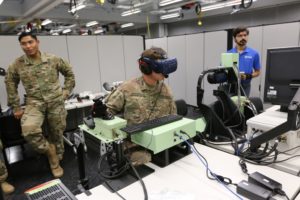Army senior leaders have tasked the team leading development of the future Synthetic Training Environment (STE) with accelerating the delivery of the system’s live training component, a lead official said Tuesday.
Maj. Gen. Maria Gervais, director of the STE Cross-Functional Team, told attendees during a virtual National Defense Industrial Association conference the call to speed up the program’s timeline is required to enable soldiers’ advanced training to support new multi-domain operational concepts.

“[Senior leadership’s] concern, amongst many, is that the sustainment of our legacy platforms are quickly out-costing the return on training, that the inability to replicate a large section of our combat capability negatively impacts readiness and that technology is readily available that can help meet the collective training demands for multi-domain operations,” Gervais said.
Gervais noted the current timeline to reach initial operational capability in fiscal year 2026 and full operational capability by FY ‘30 was “too long,” according to senior officials.
“Our current live training environment is simply unable to accurately replicate a large portion of the weapons effects organic to a Brigade Combat Team, a problem that often increases at home station,” Gervais said. “The challenge will be to realistically simulate multi-domain operations training from soldiers through Brigade Combat Team at home station, or Maneuver Combat Training Centers or even at deployed locations in live training environments.”
The live training environment portion for STE, or Increment Two, builds on the initial work to establish the system’s software foundation and selecting the hardware components, or Reconfigurable Virtual Collective Trainers (RCVT), to enable the simulated environment.
In June 2019, the Army awarded $190 million in prototype deals to software firm VT MAK, a subsidiary of VT Systems, and Vricon, a Saab and DigitalGlobe joint venture, to build STE’s software backbone (Defense Daily, June 17 2019).
Last July, the Army awarded Cole Engineering Services, Inc. a potential $81 million deal to supply RCVT prototypes for both the air and ground virtual trainers (Defense Daily, July 1 2019).
The STE CFT is now working through characteristics for the live training environment that will allow industry to offer innovative solutions rather than working to a fixed set of requirements, according to Gervais.
“It describes what we’re trying to achieve, and it really doesn’t lock the requirement in like we typically did in the traditional process,” Gervais said. “We want to use revolutionary innovations which will result in rapid leap ahead improvements to existing concepts and systems, or even completely new ways of solving problems, potentially transforming markets or economic activity.”
Gervais added her team is also starting to plan for Increment Three, which will bring together the virtual and live training environments, and enable the full scope of training requirements for multi-domain operations.
“Increment Three is the one where I want to plant the seed, because that’s our next-generation constructive [environment]. To me, that is the one that’s truly going to allow us to be able to train multi-domain operations and also meet the tenants of CJADC2, [or Combined Joint All-Domain Command and Control],” Gervais said.